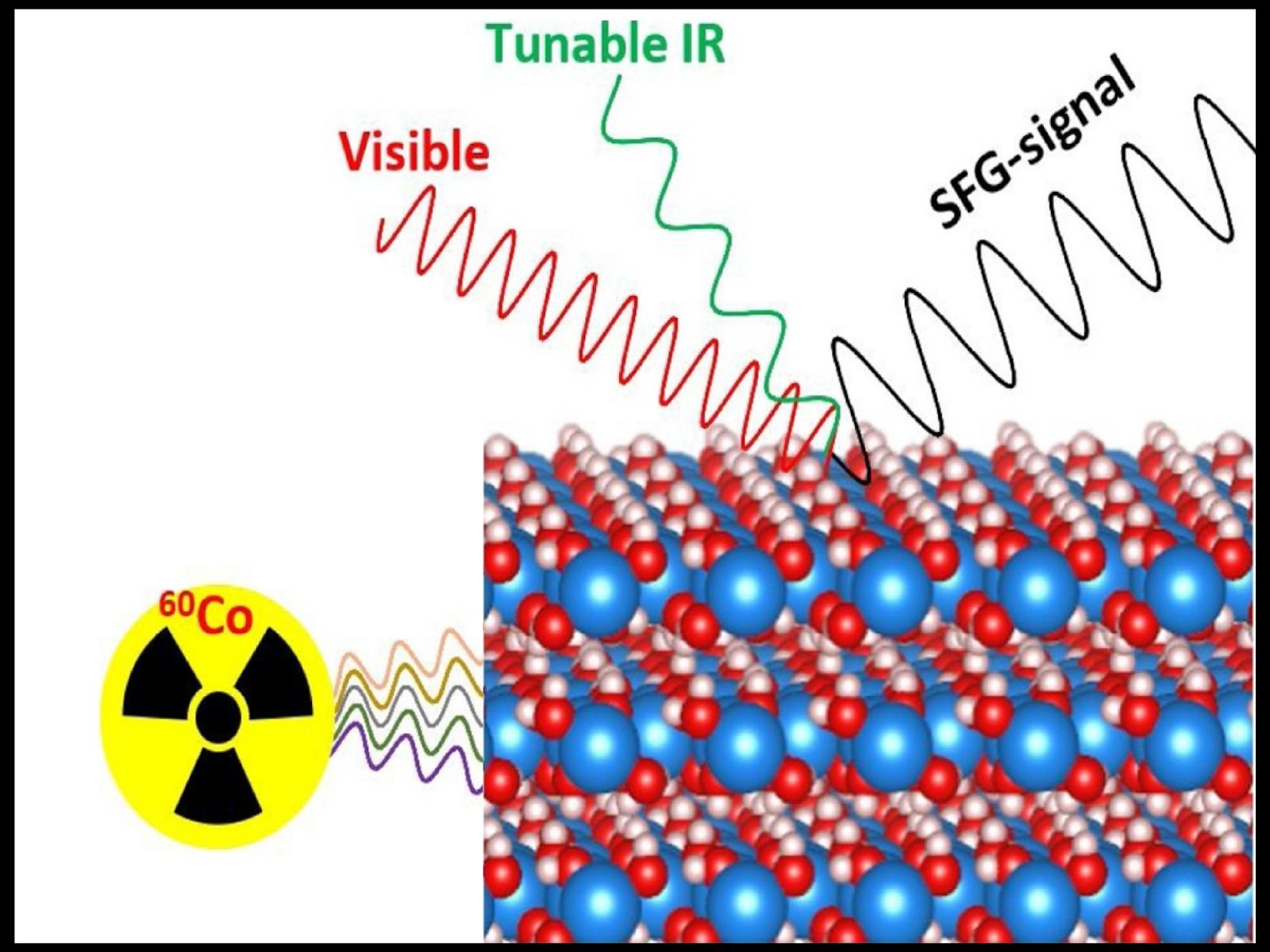Understanding the Surface Chemistry of Nuclear Waste
Quantification of gibbsite and boehmite surface radiation chemistry

Using vibrational sum frequency generation researchers can specifically measure surface hydroxyls, allowing quantification of their changes after exposure to ionizing radiation. Under gamma irradiation, the surface hydroxyls are preferentially cleaved as compared to those in the bulk solid, uncovering a mechanism that could lead to the creation of hydrogen gas in tank waste.
(Graphic: Pacific Northwest National Laboratory)
At the Hanford site in Washington State and Savannah River Site in South Carolina, underground tanks contain radioactive waste from Cold War-era weapons production. Approximately one-third of each tank contains “sludges,” which are aluminum-based solids in the form of gibbsite and boehmite. Over time, radiation in the waste modifies the surface chemistry of the solids. Limited knowledge of radiation-driven changes to the solids that can result in hydrogen generation makes waste processing challenging. Researchers hypothesized that hydrogen gas production was associated with the sludge surface radiolysis, which is the molecular decomposition of a substance by radiation.
To understand and predict the role of radiation in driving the behavior of the sludge, researchers established a technique to measure surface radiation chemistry through the use of pure phase solids.
The Science
Prior to this research, quantifying surface chemistry in radioactive environments was challenging because of the difficulty in distinguishing chemical processes that occur at the surface from those in the bulk solid.
Research conducted by scientists in the Interfacial Dynamics in Radioactive Environments and Materials (IDREAM) Energy Frontier Research Center (EFRC) revealed how surface reactions play a role in radiation chemistry. Through the adaptation of a new spectroscopic tool called vibrational sum frequency generation (VSFG), researchers can specifically measure surface interactions, allowing quantification of their changes after exposure to ionizing radiation.
This research showed that, under 60Co γ-irradiation, the surface hydroxyls are preferentially cleaved as compared to those in the bulk gibbsite and boehmite solids, contributing to the creation of hydrogen gas. Using the surface-/interface-specific spectroscopic technique of VSFG, the effect of irradiation on hydroxyl groups at particle surfaces and interior structural hydroxyls can be quantitatively discerned. Building on this knowledge, the long-term influence of radiation on the behavior of the sludge may be predicted.
The Impact
Researchers have successfully isolated hydroxyl groups on the surfaces of gibbsite and boehmite for the first time using VSFG. This has enabled identification of gamma-radiation-induced hydroxyl bond breakage at particle surfaces which contributes to radiolytic hydrogen production. This new fundamental insight may help in understanding the mechanistic pathways from radiation dose to hydrogen evolution in tank sludges, which could reduce the uncertainty associated with gas generation and inform radioactive waste processing at the Hanford and Savannah River sites.
Summary
For more than 40 years, U.S. Department of Energy (DOE) sites, such as Hanford and Savannah River, produced plutonium for our nation’s national defense. These weapons production activities generated massive quantities of radioactive wastes that have been stored in large underground tanks for many decades.
For materials, such as non-commercial aluminum-cladded spent nuclear fuels and radioactive wastes stored in tanks at Hanford and Savannah River, there is limited knowledge of radiation-driven mechanisms for hydrogen generation. Such knowledge gaps are derived from our limited ability to quantify the role of radiation in driving thermal and chemical reactions in bulk solids and at interfaces. Distinguishing and quantifying interfacial radiolysis processes from those occurring in bulk irradiated solids has been challenging.
One of the goals of IDREAM is to quantify interfacial radiolysis and its role in driving the generation of reactive species, such as hydrogen. At Pacific Northwest National Laboratory (PNNL), researchers have used Laboratory Directed Research and Development resources to develop a unique VSFG capability that combines visible and tunable infrared laser beams to selectively probe the functional groups at particle surfaces. VSFG spectroscopy is one of the very few techniques capable of isolating and characterizing surface hydroxyl groups from hydroxylated moieties within the bulk structure. The IDREAM EFRC has used this new tool to study materials that are relevant to DOE’s Environmental Management mission. Boehmite and gibbsite materials are found in radioactive wastes at Hanford and Savannah River, mostly due to the dissolution of aluminum-cladded spent nuclear fuel.
Funding
PNNL’s Nuclear Process Science Initiative, a multi-year, internally funded effort that concluded in September 2020, supported development of the unique VSFG capability. IDREAM is an EFRC funded by the DOE Office of Science, Basic Energy Sciences program. This research was performed at the William R. Wiley Environmental Molecular Science Laboratory at PNNL, a national scientific user facility sponsored by the DOE Biological and Environmental Research program.
Research Team
PNNL’s Zheming Wang, Eric Walter, Michel Sassi, Xin Zhang, Hailin Zhang, Xiaohong Li, Ying Chen, Wenwen Cui, Aashish Tuladhar, Zizwe Chase, Austin D. Winkelman, Carolyn Pearce, Sue Clark, Kevin Rosso, and Hong-Fei Wang (Fudan University, Shanghai, China)
The team’s findings, “The role of surface hydroxyls on the radiolysis of gibbsite and boehmite nanoplatelets,” published November 5, 2020, in the Journal of Hazardous Materials (DOI: 10.1016/j.jhazmat.2020.122853).
Published: May 6, 2021
Wang, Z., Walter, E.D., Sassi, M., Zhang, X., Zhang, H., Li, X.S., Chen, Y., Cui, W., Tuladhar, A., Chase, Z., Winkelman, A., Wang, H., Pearce, C., Clark, S.B., and K.M. Rosso. 2020. The role of surface hydroxyls on the radiolysis of gibbsite and boehmite nanoplatelets. Journal of Hazardous Materials, 398, 122853 [DOI: 10.1016/j.jhazmat.2020.122853].